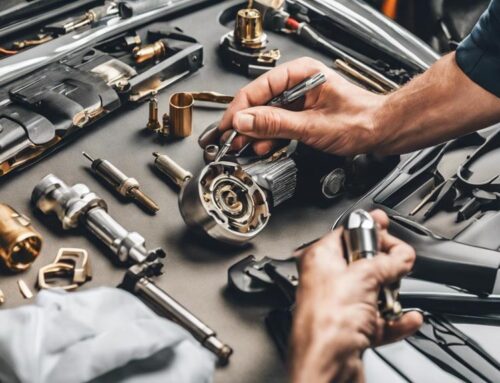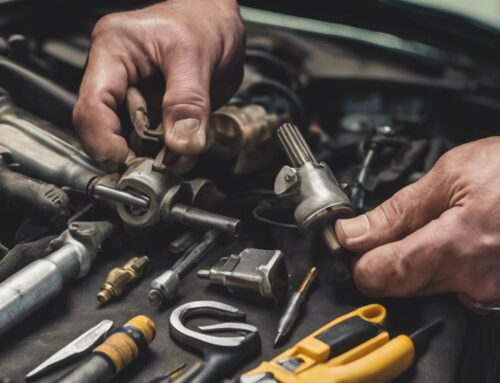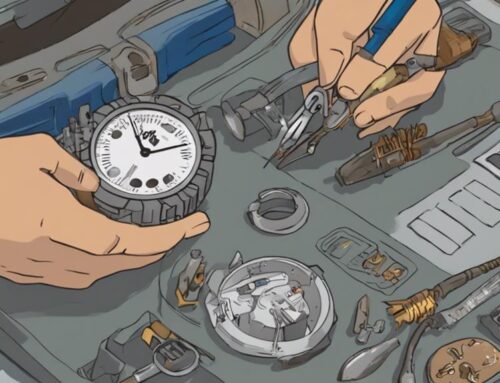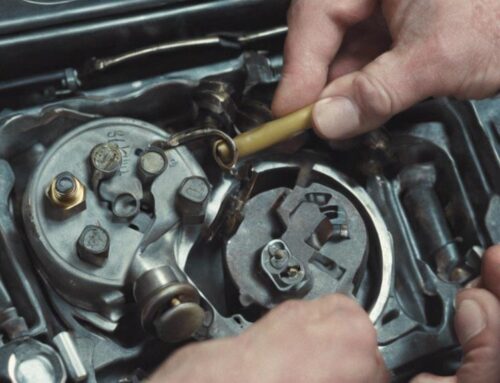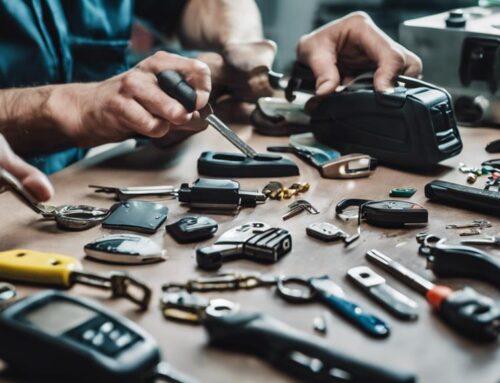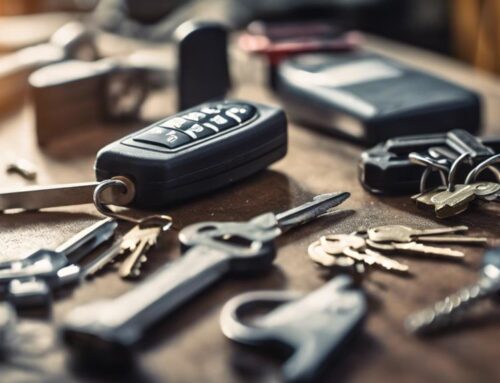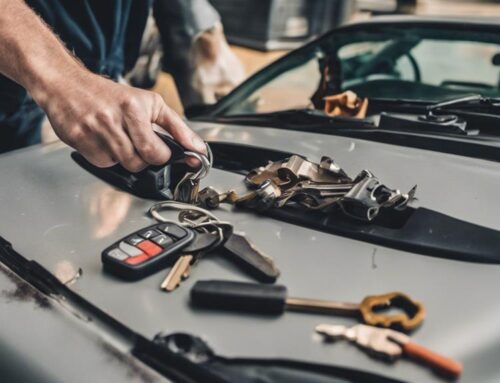Did you know that nearly 30% of keyless entry remote issues stem from programming errors? You might find that frustrating, especially when you've followed the steps diligently. Understanding the common pitfalls, like incompatible key fob models and environmental interference, can save you time and hassle. So, what can you do to avoid these malfunctions and guarantee your keyless entry system works flawlessly? Let's explore some practical strategies to help you maintain peak performance.
Key Takeaways
- Ensure key fob compatibility with your vehicle's make and model to avoid programming errors.
- Follow the programming procedure meticulously, avoiding missed steps or distractions during the process.
- Keep the remote away from other wireless devices to minimize signal interference during programming.
- Regularly check and replace the battery every 1-2 years to maintain optimal remote performance.
- Inspect wiring and components for damage, and clean remote contacts to prevent operational failures.
Understanding Keyless Entry Remotes
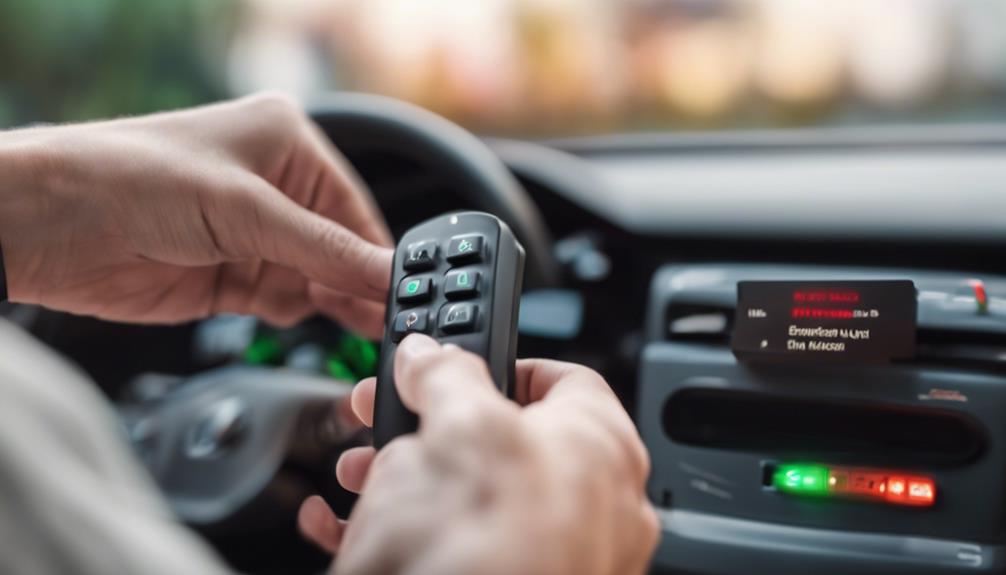
Keyless entry remotes have become essential tools for vehicle access and security, allowing you to open your car with just a press of a button. These devices embody keyless convenience, streamlining your daily routine while enhancing remote security. By utilizing advanced technology, they transmit encrypted signals to your vehicle, ensuring that only authorized users gain access. Locksmiths can reprogram or replace existing keyless entry remotes, handling different types with expertise Can Locksmiths Handle Keyless Entry Remotes. Understanding the components of keyless entry remotes—such as the transmitter, receiver, and battery—is vital for maximizing their functionality. Regular maintenance, including battery checks and signal testing, can prevent operational failures. Additionally, knowing your vehicle's specific programming requirements can empower you to troubleshoot issues effectively. With these insights, you can leverage the full capabilities of your keyless entry system, reinforcing both convenience and security.
Common Programming Errors
When programming a keyless entry remote, it's common to encounter several errors that can hinder successful syncing with your vehicle. These common programming errors can negatively impact your user experience, but you can easily troubleshoot them with the right tips. Here are some issues to watch for:
- Incorrect key fob model
- Failure to follow programming steps precisely
- Interference from other electronic devices
- Low battery in the remote
- Programming mode not activated in the vehicle
- Make sure to check the Unlocking Keyless Entry Remote Programming Explained for additional insights on troubleshooting these common errors.
Battery Issues and Solutions
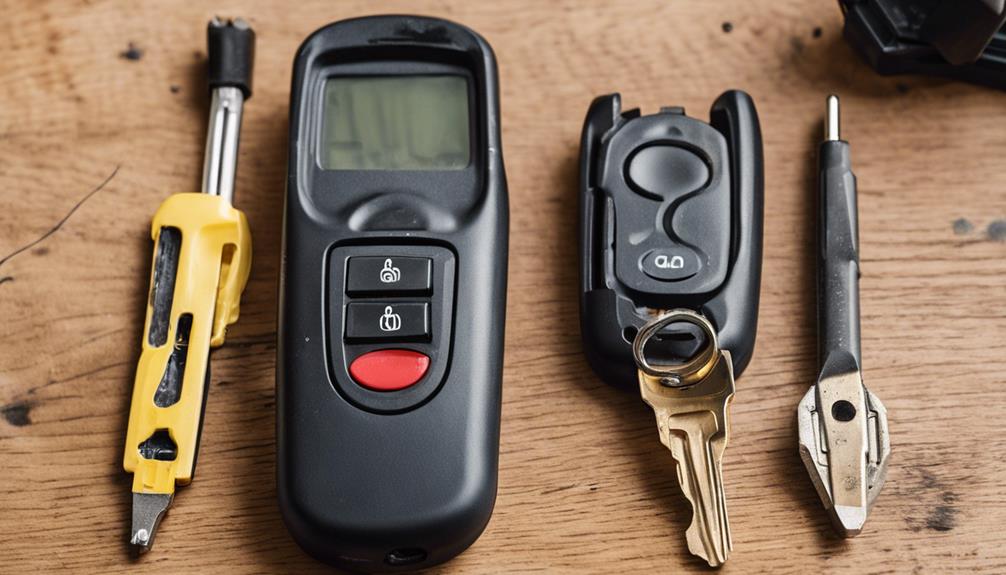
Battery life duration is essential for your keyless entry remote's functionality. If you're experiencing issues, make sure you've installed the battery correctly, as improper installation can lead to malfunctions. Regularly check and replace batteries to avoid programming issues down the line. Additionally, understanding the common issues with key fobs, as discussed in Can Locksmiths Handle Key Fobs for Any Vehicle, can help you troubleshoot and prevent malfunctions effectively.
Battery Life Duration
Maintaining ideal battery life is vital for the reliable performance of your keyless entry remote. A well-managed battery lifespan guarantees energy efficiency, preventing unexpected failures. Here are some strategies to enhance battery longevity:
- Regularly check battery status.
- Replace old batteries promptly.
- Avoid excessive button pressing.
- Store the remote in a cool, dry place.
- Use high-quality batteries from reputable brands.
To make sure your keyless entry remote functions at its best, regularly checking the battery status is essential. A well-maintained battery not only prolongs the lifespan of your remote but also helps prevent unexpected failures.
Proper Installation Steps
To guarantee your keyless entry remote operates smoothly, follow these essential installation steps for changing the battery. First, gather your installation tools: a small screwdriver and a new battery. Carefully open the remote casing using the screwdriver, ensuring you don't damage any clips. Remove the old battery, noting its orientation for proper remote alignment. Insert the new battery in the same orientation, ensuring it fits snugly. Reassemble the casing securely, making sure all clips snap back into place. Test the remote to confirm it functions as intended. If problems persist, double-check the battery's alignment and connection. By adhering to these steps, you'll greatly reduce the risk of battery-related malfunctions and enhance your keyless entry system's reliability.
Interference From Other Devices
Interference from other devices can greatly disrupt keyless entry remote programming. Signal interference can stem from various electronic devices, affecting your remote's performance and reliability. To minimize these disruptions, consider the following:
- Confirm device compatibility with your keyless entry system.
- Keep your remote away from other wireless devices during programming.
- Turn off nearby electronic gadgets that may cause interference.
- Use a designated programming area free from environmental signals.
- Regularly check for firmware or software updates on your devices.
- Additionally, make certain to understand how different vehicle systems interact with keyless entry remotes to prevent signal interference.
Incompatible Key Fob Models

Signal disruptions aren't the only issue that can hinder keyless entry remote programming; using an incompatible key fob model can also lead to significant problems. When selecting a key fob, it's essential to guarantee key fob compatibility with your vehicle's make and model. Each vehicle has specific model specifications that dictate which key fobs work effectively. If you attempt to program a key fob that doesn't match these specifications, you'll likely face programming failures or erratic behavior. To prevent these malfunctions, always verify the compatibility of your key fob before purchasing. Consult your vehicle's owner manual or a trusted dealer to confirm that the key fob meets the required model specifications, guaranteeing a seamless programming experience.
Faulty Wiring and Components
Faulty wiring and components can create major obstacles during keyless entry remote programming. To guarantee a smooth programming experience, you should prioritize regular wiring inspections and timely component replacements. Neglecting these can lead to frustrating malfunctions. Here are some key areas to focus on:
- Check for frayed or damaged wires.
- Verify connectors are secure and corrosion-free.
- Test the battery connections for proper voltage.
- Inspect the control module for signs of wear.
- Replace any faulty components immediately. Additionally, locksmiths can often program key fobs for multiple vehicles, offering a convenient solution for those with more than one car Can Locksmiths Program Key Fobs for Multiple Vehicles.
Programming Procedure Mistakes
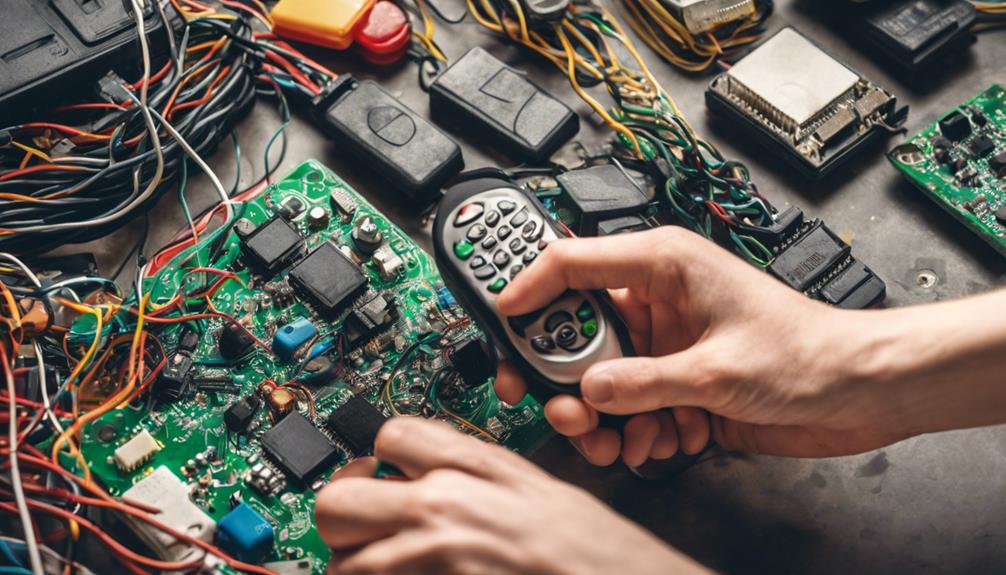
Programming keyless entry remotes can be tricky, and mistakes during the procedure often lead to frustrating setbacks. One common error is skipping steps in the programming sequence; this can render your remote useless. Always follow the manufacturer's guidelines closely. Additionally, verify your remote's battery is fresh before starting. This small detail can save you from unnecessary troubleshooting techniques later.
Another frequent mistake is assuming all remotes are compatible; verify that your remote matches your vehicle's specifications. To enhance your success, utilize programming tips such as performing the procedure in a quiet environment to avoid distractions. Finally, if issues persist, consider resetting the vehicle's electronic systems before reattempting the programming process. Taking these precautions can empower you to achieve smooth keyless entry remote programming.
Environmental Factors Affecting Performance
Even after following the correct programming procedures, environmental factors can considerably impact the performance of keyless entry remotes. To guarantee peak functionality, be aware of the following influences:
- Weather conditions: Rain, snow, or extreme heat can hinder signal transmission. In areas prone to harsh weather conditions, consider installing protective covers or enclosures to shield the remote from seasonal changes.
- Temperature extremes: High or low temperatures can cause battery issues or internal component failure.
- Humidity levels: Excess moisture can lead to corrosion and short circuiting.
- Electromagnetic interference: Nearby electronics can disrupt the remote's signal.
- Physical obstructions: Walls, vehicles, or other barriers can block the signal pathway.
Seasonal changes and environmental wear also play a role in the longevity and reliability of your keyless entry system. Stay vigilant and take precautions to mitigate these factors for optimal performance.
Maintenance Tips for Longevity
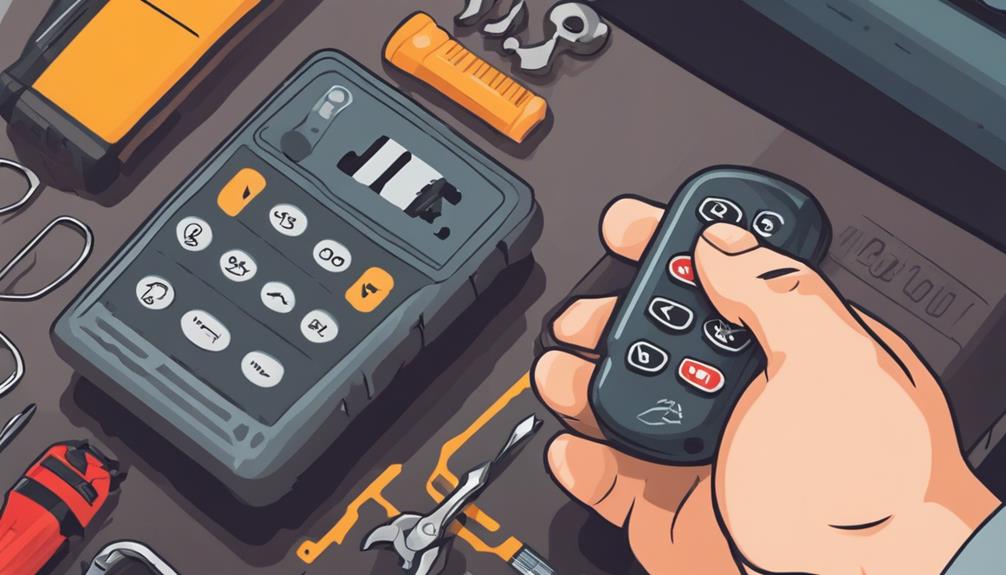
To guarantee your keyless entry remote lasts, you should regularly replace its battery, as a weak battery can lead to performance issues. Additionally, cleaning the remote's contacts helps maintain a strong connection and prevents signal loss. By following these simple maintenance steps, such as essential care tips for keyless entry systems, you can considerably extend the life of your remote.
Regular Battery Replacement
Keeping your keyless entry remote in top shape hinges on regular battery replacement. Different key fob types require specific batteries, so knowing your remote's requirements is vital. To guarantee peak performance, follow these guidelines:
- Replace batteries every 1-2 years.
- Use high-quality battery brands for reliability.
- Check the battery compartment for corrosion.
- Confirm the battery is seated properly.
- Test the remote after replacement to verify functionality.
- It's also important to check for signs of battery corrosion to prevent damage to the internal components.
Clean Remote Contacts
Maintaining clean remote contacts is essential for ensuring your keyless entry remote functions effectively. Over time, dirt, debris, and oxidation can accumulate on the contacts, leading to unreliable operation. To prevent malfunctions, perform regular remote cleaning using a soft, lint-free cloth and isopropyl alcohol. Gently wipe the contact surfaces to remove any grime. For deeper contact maintenance, consider using a contact cleaner designed for electronics, ensuring it's safe for plastic components. After cleaning, let the remote dry completely before reassembling. By keeping your remote contacts clean, you enhance the performance and longevity of your keyless entry system, ensuring you have reliable access to your vehicle when you need it most.
How Low Rate Locksmith Can Help
When dealing with keyless entry remote programming issues, Low Rate Locksmith offers specialized services to resolve your problems efficiently. Their expertise guarantees that you regain control over your access systems without hassle. Here's how they can assist you:
- Thorough locksmith services for all keyless entry systems
- Remote assistance to diagnose and fix programming issues swiftly
- On-site support, minimizing downtime and inconvenience
- Expert advice on maintaining your keyless entry system
- Customized solutions tailored to your specific needs
With Low Rate Locksmith, you'll experience a seamless approach to troubleshooting and enhancing your keyless entry functionality. Don't let programming issues hinder your security; trust their professionals to deliver effective and reliable results.


